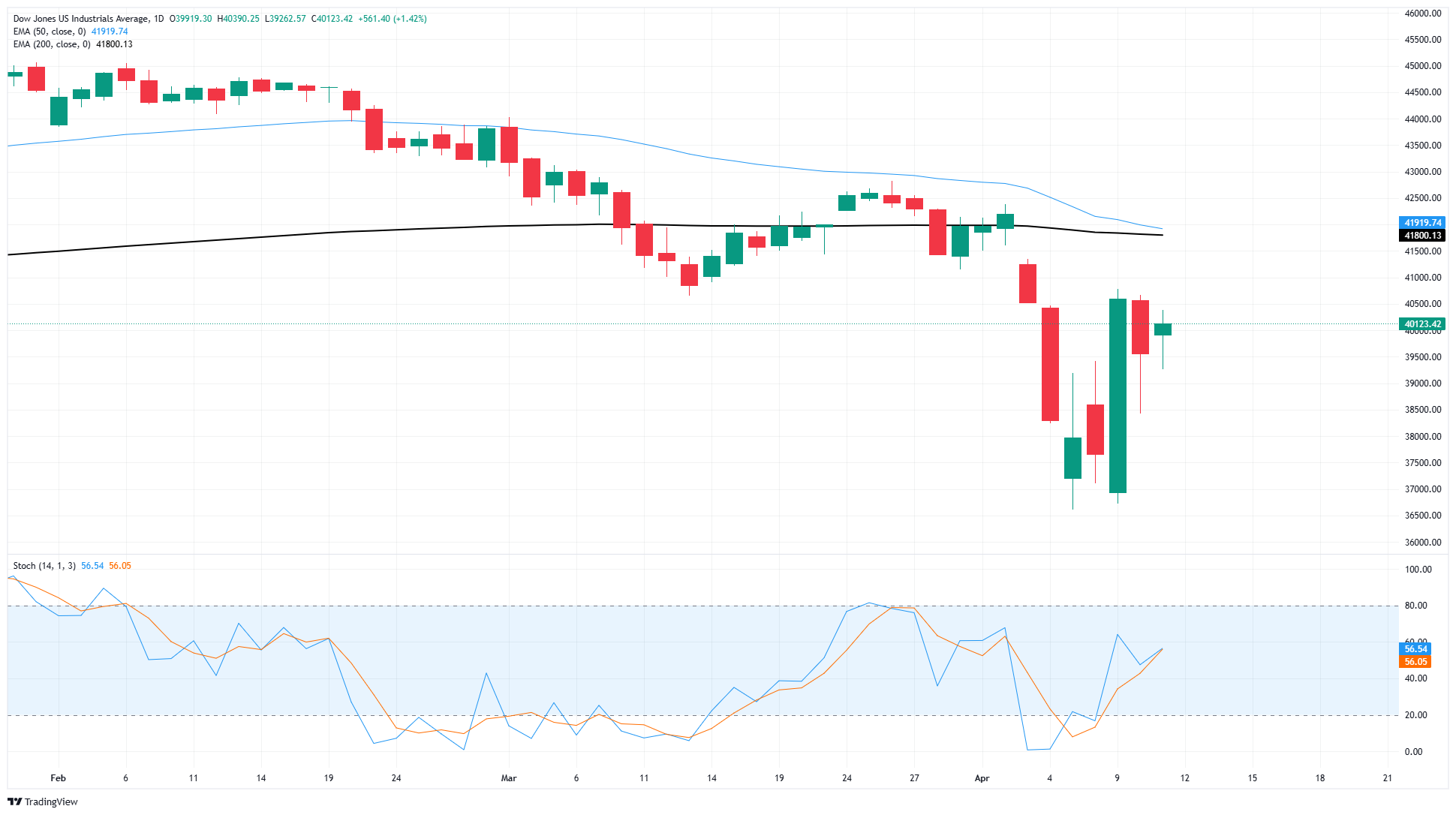Dow Jones Industrial Average gains ground as investors try to shrug off new tariffs from China
- The Dow Jones stuck to 40,000 on Friday after a brief dip on fresh tariff concerns.
- US data came in soft across the board, with consumer sentiment plummeting and PPI inflation easing.
- Ongoing trade tensions will continue to weigh on markets as China and the US square off.
The Dow Jones Industrial Average (DJIA) caught a late bid on Friday, rising back into the 40,000 major price handle after an early dip on rising tariffs between the US and China. China has raised tariffs on US imports to 125% as the country continues to retaliate against rocketing tariffs imposed on Chinese goods imported into the US, which have risen to 145%.
Despite triple-digit tariffs in both directions, White House personnel remain adamant that President Trump remains optimistic that a trade deal between the US and China will be reached, helping to bolster investor sentiment. The Dow Jones gained nearly 600 points on Friday, putting the major equity index up 1,800 points for the week. The DJIA still remains down sharply from record highs, but equities broadly recovered ground this week after the Trump administration pivoted away from its own lopsided “reciprocal” tariffs once again.

US Producer Price Index (PPI) inflation eased even faster than expected in March, with core PPI falling to 3.3% YoY. However, inflation pressures continue to cook in the background as markets wait to see how quickly tariff fallout will bleed over directly into the US economy.
University of Michigan (UoM) Consumer Sentiment survey results showed that broad-base tariff tensions are eating away at the consumer-level economic outlook and inflation expectations. The UoM Consumer Sentiment Index fell to multi-year lows of 50.8, and the Consumer Expectations Index declined to an all-time low of 47.2 as more consumers expect a recession in the coming year.
Consumer 1-year Inflation Expectations soared to 6.7% from 5.0%, and Consumer 5-year Inflation Expectations also accelerated to 4.4% from 4.1%. Consumers are growing increasingly uneasy in the face of widespread tariffs, and inflation expectations are at risk of becoming unanchored with import prices set to rise across the board.
Dow Jones price forecast
The Dow Jones Industrial Average caught another bid on Friday, just enough to muscle the Dow Jones back above the 40,000 handle to round out an incredibly volatile week. The DJIA hit 16-month lows near 36,600 before surging back into the high side on geopolitical headlines.
Price action is still caught on the bearish side of the 200-day Exponential Moving Average (EMA) at 41,875, but bullish momentum is on pace to continue grinding bids higher. A long-term technical inflection point rests at the 41,000 handle, near the mid-March swing low point.
Dow Jones daily chart

Dow Jones FAQs
The Dow Jones Industrial Average, one of the oldest stock market indices in the world, is compiled of the 30 most traded stocks in the US. The index is price-weighted rather than weighted by capitalization. It is calculated by summing the prices of the constituent stocks and dividing them by a factor, currently 0.152. The index was founded by Charles Dow, who also founded the Wall Street Journal. In later years it has been criticized for not being broadly representative enough because it only tracks 30 conglomerates, unlike broader indices such as the S&P 500.
Many different factors drive the Dow Jones Industrial Average (DJIA). The aggregate performance of the component companies revealed in quarterly company earnings reports is the main one. US and global macroeconomic data also contributes as it impacts on investor sentiment. The level of interest rates, set by the Federal Reserve (Fed), also influences the DJIA as it affects the cost of credit, on which many corporations are heavily reliant. Therefore, inflation can be a major driver as well as other metrics which impact the Fed decisions.
Dow Theory is a method for identifying the primary trend of the stock market developed by Charles Dow. A key step is to compare the direction of the Dow Jones Industrial Average (DJIA) and the Dow Jones Transportation Average (DJTA) and only follow trends where both are moving in the same direction. Volume is a confirmatory criteria. The theory uses elements of peak and trough analysis. Dow’s theory posits three trend phases: accumulation, when smart money starts buying or selling; public participation, when the wider public joins in; and distribution, when the smart money exits.
There are a number of ways to trade the DJIA. One is to use ETFs which allow investors to trade the DJIA as a single security, rather than having to buy shares in all 30 constituent companies. A leading example is the SPDR Dow Jones Industrial Average ETF (DIA). DJIA futures contracts enable traders to speculate on the future value of the index and Options provide the right, but not the obligation, to buy or sell the index at a predetermined price in the future. Mutual funds enable investors to buy a share of a diversified portfolio of DJIA stocks thus providing exposure to the overall index.

